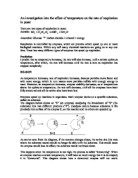Chris Scrimgour
Investigating the effect of temperature on yeast respiration.
Planning:
With references to my theories I predict that when performing the experiment, the rate and speed of respiration of yeast will increase with temperature rise, up until a certain point around the area of 40ºC and onwards. After this point the enzyme site will become de-natured, meaning the substrate can no longer fit into the site and the protein bonds from the enzyme will begin to snap. My prediction is based upon two scientific theorems, “lock and key” hypothesis and the “collision” theory. The lock and key hypothesis, is where the substrate, the “key”, fits into the active site on the enzyme, the “lock”. Once this has occurred they then bind together and a reaction takes place, the active site on the enzyme unlocks the substrate to form one or more new substances leaving the enzyme ready to perform the binding process again. However the enzyme can only bind with a substrate that fits the shape of the active site, unique to that enzyme and once the temperatures pass 40ºC the sensitive active site becomes altered drastically, this process can hardly ever take place, and this is called denaturisation. Therefore, it is upon that information which my prediction is based, when I say that the temperature will have an effect on the respiration of the yeast up until a certain point around the area of 40ºC and onwards. The second piece of information on which my prediction is based is the “collision” theory. The collision theory states that, with an increase in temperature, the rate of reactions will increase. This is due to the increase in speed of the particles, brought about by the extra energy given to them by the heat. The faster the particles move the more particle collisions and so the reaction will occur faster. The reactions that take place in the enzymes will be quicker and so will create more of their products. It has been said that there is a doubling in the rate of reactions for every 10ºC rise in temperature. This is called the “Q10=2” theory.
My experiment will be set up, as show in the following diagram. It will consist of a boiling tube, with an amount of yeast in it, suspended in a beaker with an amount of water in it. The beaker will be sat on a gauze supported by a tripod and the Bunsen burner will be placed underneath the tripod set on its highest temperature, to heat the beaker and its contents. A bung with an attached delivery tube will be placed into the top of the boiling tube. This delivery tube will be placed into a water bath where the end of the tube will be put into the bottom of the suspended burette, to measure the amount of gas collected.
The beaker will be filled with 200ml of water, I decided that this will be a good amount of water to use as it will not be nearly over flowing, it is not a very small amount and it will nearly submerge the suspended boiling tube containing the yeast. The boiling tube will be filled two thirds full with yeast. I decided it will be done this way because then the boiling tube will not be too full yet will not be too empty. The bung will still be able to be placed in the top, as it will not be too full and filling the boiling tube around two thirds full will mean that the yeast will not produce so much gas that it can no longer be measured in the burette. I decided I will use a burette in my experiment, because these pieces of apparatus are designed to collect gas, they have measurement markings on, and therefore the readings can be easily taken. The burettes are also within my price range and are available for use. These pre-tests are all vitally important as they help to decide the process of the experiment. The boiling tube containing the yeast will be kept in the correct, desired temperature for a total of 15 minutes. However, for the first 5 minutes the yeast will only be acclimatising to the temperature set in the beaker, and the delivery tube will not be placed under the burette. If the delivery tube was placed under the burette for the first 5 minutes, the burette would only be collecting the hot expanded air from the boiling tube, not the actual amount of respiration from the yeast. After the 5 minutes acclimatisation time, the delivery tube, from the boiling tube containing the yeast will be placed under the burette, to begin the measure of the yeast respiration. I will allow it 10 minutes, I will use this amount of time as it will not be so short of a time that no amount of gas can be produced and it will not be such a long time that too much gas will be produced for the burette to hold. I will find the amount of respiration from the yeast over, seven different temperatures. These temperatures will be 0ºC, 20ºC, 35ºC, 40ºC, 50ºC, 60ºC, 80ºC. I will measure it across these temperatures because I feel that these are a good temperature range and they include some upper high temperatures and also some lower temperatures and collectively they provide a large temperature range. The experiments will have to be carried out more than just once, that will allow me to achieve raw data and processed data such as an average.








